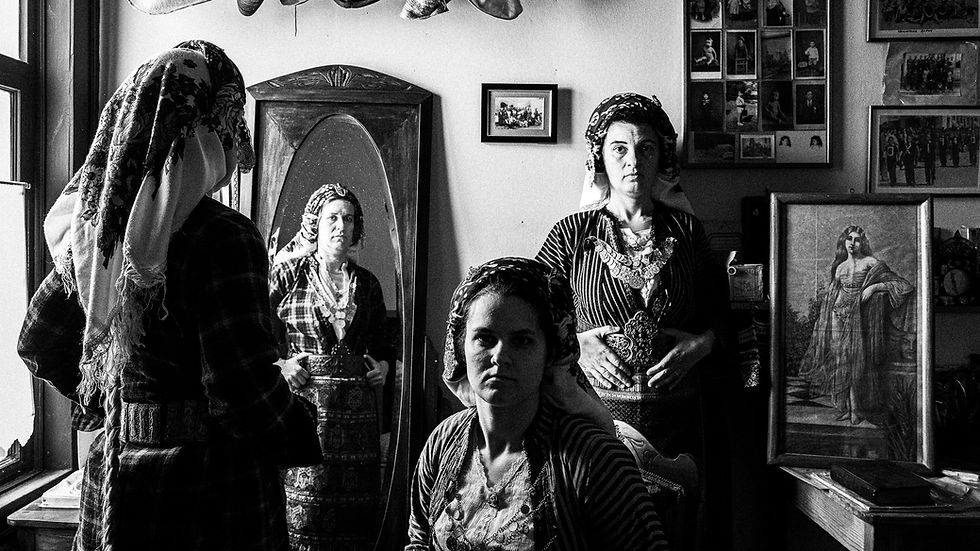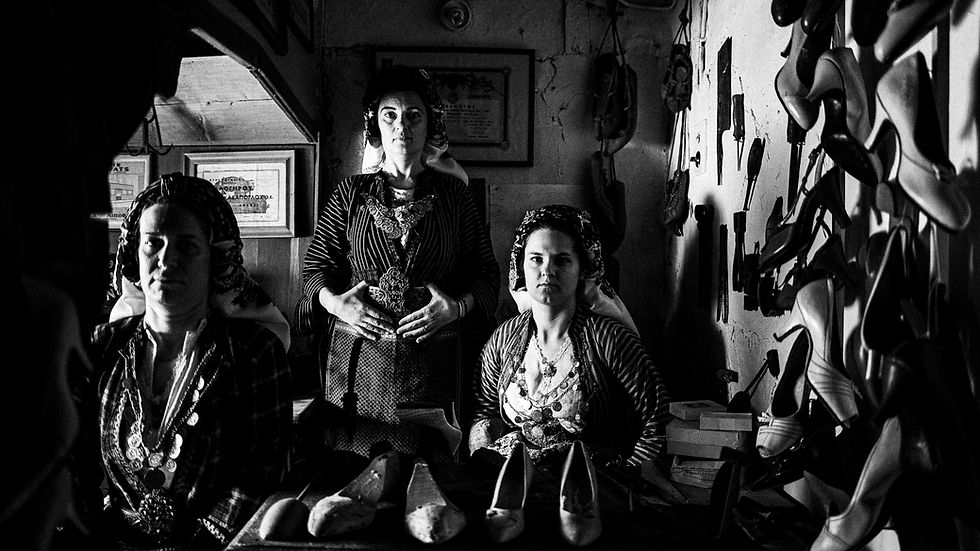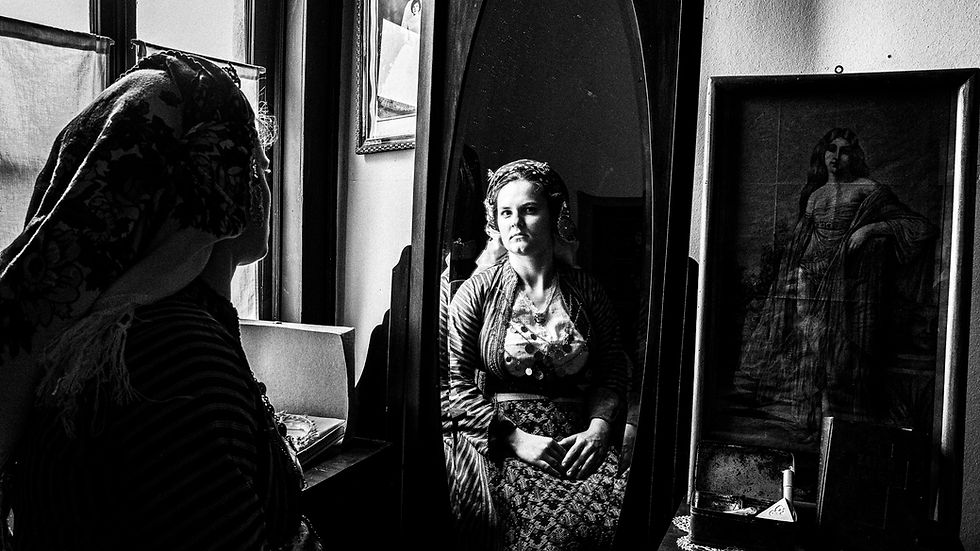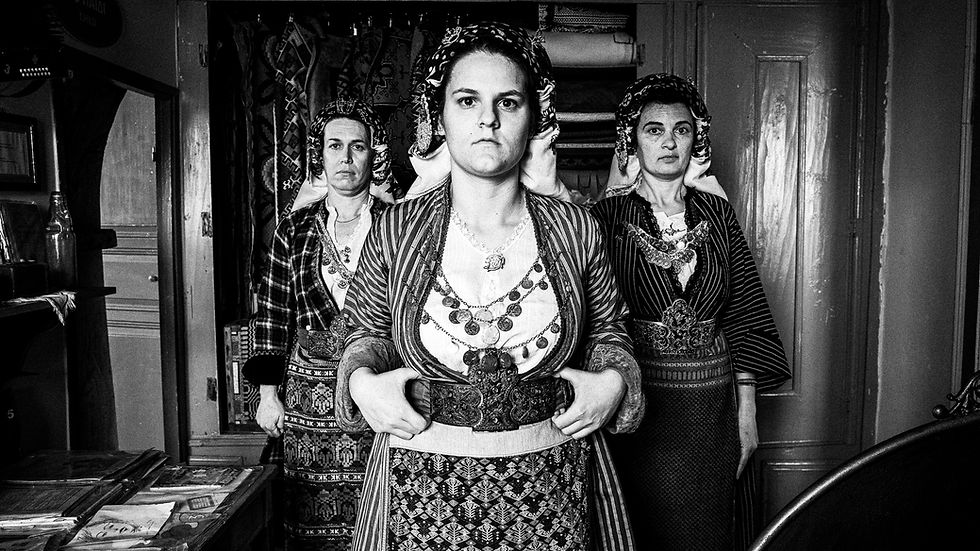Finding Inspiration in Soufli: A Journey through Thrace’s Traditional Culture
- George Tatakis

- Jul 17
- 12 min read
Updated: Aug 28
Finding Inspiration in Soufli, Thrace: A Photographer's Journey
Intro – The Search for Inspiration
As a photographer, I’ve learned that inspiration can emerge from the most unexpected places. Something as simple as a silk tie recently set me off on a new creative quest. That small spark, inspired by a tie, led me to Soufli, a remote town in Thrace, Greece, in search of fresh perspectives. Soufli is famous for its silk and rich cultural heritage, and I hoped that immersing myself in this “city of silk” would rekindle my artistic vision. So, with my camera packed, I embarked on a journey to northeastern Greece, eager to capture the traditional Greek culture of Soufli through my lens. This travelogue shares the story of that adventure, through history and scenery, roots and stories, and ultimately through the hard work of making photographs.
I also documented this trip in a short vlog film – you’ll find the video embedded below – but here, I want to take you deeper into the experience.
My drive north felt like travelling back in time. The farther I went, the more modern highways gave way to narrow roads flanked by endless rows of mulberry trees and cotton fields. By the time I reached Soufli, I was truly off the beaten path – just 500 meters from the Turkish border, near the banks of the Evros. This little town was once a thriving silk-producing centre in the 19th century, and remnants of that era are still visible. I arrived with a sense of curiosity and humility, ready to learn from Soufli’s people and heritage. What follows is how I found inspiration through Soufli’s history, scenery, roots, stories, and the work itself – and how those elements intertwined to reignite my passion for photography.
Join me on this journey through words and images. I invite you to explore the black-and-white photographs I captured (featured throughout this post), each one a piece of Soufli’s story. All images are available as fine-art prints – simply click the links on each photo if you wish to **collect a print** from this series and bring a piece of Soufli’s tradition into your home. 📷

Inside a traditional Soufli home filled with memories – Two local women wear the **traditional Soufli costumes** amid antique furniture and old family photographs on the wall. (This black-and-white photograph is available as a fine-art print.)
Finding Inspiration through History
Stepping into Soufli felt like stepping into a living museum. On my first day, I visited a local silk museum housed in a beautifully preserved neoclassical mansion. The creaking wooden floors and displays of old looms and cocoon-reeling devices immediately transported me to another era. I learned that from the 19th century, Soufli was one of Europe’s most important silk-producing towns. Its silk was exported to fashion houses in France and Italy until synthetic fabrics in the mid-20th century sent the industry into decline. Recently, however, there’s been a revival effort, and walking through the museum, I could sense the town’s pride in its silk legacy.
One exhibit that struck me showed how mulberry groves once blanketed the banks of the Evros River – the leaves feeding countless silkworms. Many families turned the upstairs of their homes into “Koukoulospita” (cocoon houses) where silkworms were raised. Imagining those times, I felt a deep appreciation for the intersection of nature, industry, and tradition that defines Soufli’s history.
Armed with this historical insight, I found new meaning in photographing Soufli’s people and places. I was no longer just an outsider with a camera; I was a student of their heritage, trying to honour it through my work. In the evenings, I would stroll around the town’s old quarter, where abandoned silk factories stand as monuments to the past. The patina of peeling paint on factory walls and the vintage advertisements for silk products became creative fuel for my compositions. I even found inspiration in small details – a pattern on a vintage silk tie displayed in the museum’s shop reminded me that behind every thread and design, there’s a story reaching back generations. History was coming alive before my eyes, and through my lens, I aimed to freeze those living memories in time.

Reflections of the past – Three women of Soufli in traditional dress, captured in a historic mansion. The walls around them are adorned with photos of ancestors, underscoring Soufli’s proud **historical continuity**. (Fine-art print available)
Finding Inspiration through Scenery
Thrace’s landscape itself became a source of inspiration during my journey. The scenery of Soufli and its surroundings is unlike anywhere else in Greece I’ve travelled. Early one morning, I drove out to the edge of town where the Evros River winds its way along the Greek-Turkish border. A light mist hung over the riverbanks, and I could hear distant bird calls from the nearby Dadia Forest. The sunrise broke through in soft rays, illuminating the twin hills of Prophet Elias that rise above Soufl.
Standing there, camera in hand, I felt the significance of place – this remote corner of Greece, with one foot in the East and one in the West, has a quiet magic. The open sky, the rustic farms, and the silhouette of minarets from across the border all blended into a scene that reminded me how travelling to Thrace can expand a photographer’s eye. There is a certain raw authenticity here that inspires creative work; the land feels storied.
Even within the town, the environment contributed to my images. Soufli’s streets are lined with old stone houses and mansions once owned by wealthy silk merchants. Many have distinctive architectural touches: ornate wooden balconies, colored glass windows, and courtyards overgrown with vines. I found an old cobbler’s workshop on a side street – a small stone building where dusty leather shoes and antique tools still lay about, as if the shoemaker had just stepped out for a moment.
The way the light filtered through the workshop’s window in the late afternoon was a gift for my photography. I composed a shot where the beams of sunlight cut across hanging shoe moulds and a vintage Singer sewing machine, highlighting particles of dust in the air. In that moment, the scenery and the subject merged: the space itself told a story (of a way of life and work) and provided the perfect setting for a portrait. The natural light, the textures of peeling walls, and the objects left behind all created a richly inspiring tableau. It reminded me that sometimes you don’t need dramatic mountains or famous landmarks for inspiration – ordinary scenes rich with character can be just as powerful for a photographer.

A workshop frozen in time – Inside an old shoemaker’s shop in Soufli, three women pose amid vintage tools and shoe moulds. The **natural light** streaming in and the textured walls give this photograph a timeless atmosphere. Scenes like this showcase Thrace’s unspoilt charm; even simple workspaces become beautiful in the right light. (This image is available as a print – a piece of authentic Thracian scenery for your wall.)
Finding Inspiration through Roots
One of the most rewarding parts of this journey was connecting with the cultural roots that Soufli represents. As a Greek photographer, I’ve always been drawn to documenting our country’s traditions – from island festivals to mountain village customs – but Thrace remains an exciting territory for me. In Soufli, I discovered traditions that run incredibly deep.
The local women’s costumes, for example, are not just outfits; they are heirlooms and symbols of identity passed down through generations. Each garment, from the intricately woven silk headscarves to the coin-laden necklaces, carries the imprint of those who made and wore it decades or even centuries ago. When I saw young women donning their grandmothers’ dresses for our photo sessions, I realised I was witnessing a living continuum. It was inspiring to see how the past lives on in the present here.
On a personal level, being in Soufli also made me reflect on my own roots. While I don’t have family from this region, as a Greek, I felt a sense of kinship and pride that such places and practices still survive in our modern age. One quiet afternoon, I sat in the cool interior of a traditional house with my hosts, sipping a local herbal tea. Around us were walls decorated with portraits of ancestors and shelves filled with hand-embroidered textiles.
It struck me that many of these people in the photographs had likely sat in this same room long ago, dressed in the same style of clothes we were photographing. I felt almost as if I were time-travelling. That emotional realisation – that my photography could capture not just faces and costumes, but the very spirit of Greek heritage – was profoundly motivating. It’s the kind of feeling that reminds me why I do what I do.

Reflecting on heritage – A young Soufli woman sees herself in the mirror, dressed in the ornate costume of her forebears. This intimate black-and-white portrait symbolises the connection between past and present: she **reflects her roots**. Photographing such moments, I felt the power of tradition shaping personal identity. (Print available)
Through these experiences, I learned that “finding inspiration through roots” often means finding a piece of yourself in the story. By reconnecting with the foundational elements of culture – family, community, history – I was able to infuse more meaning into my photographs. Each click of the shutter became a small tribute to those roots. In Soufli, I wasn’t just an observer; I became a participant in the continuum, if only for a brief time. And that feeling will stay with me far beyond this trip.
Finding Inspiration through Stories
Every photographer knows that behind every great photograph is a great story (or several). In Soufli, the stories I encountered were endless and heartwarming. One of my favourite memories is meeting a trio of local women who volunteered to wear their family costumes and model for my project. As we prepared for the shoot, they shared the stories behind each garment.
One woman’s embroidered vest had been stitched by her great-grandmother over a century ago – she pointed out tiny initials in the corner of the fabric, and her eyes shone with pride as she told me this. Another woman jingled the dozens of old gold coins sewn into her bodice and explained they were traditionally part of a bride’s dowry, passed from mother to daughter. Suddenly, the costumes were no longer just beautiful attire; they were storytellers themselves, carrying tales of marriages, migrations, and memories. Listening to these ladies, I felt a tremendous responsibility to do their stories justice through my images.
Beyond the costumes, the town offered up its own narratives. I learned about Soufli’s silk industry legends – like how secret silk eggs were supposedly smuggled out of China by monks in hollow canes (a popular tale linked to the Byzantine silk trade), eventually giving rise to places like Soufli thriving in sericulture. Locals also told me about the tough times: the decline of silk production during WWII and how the community suffered when many left to find work elsewhere. But they spoke just as eagerly about the resurgence – how a new generation is returning to reopen silk workshops, start guesthouses, and keep the tradition alive.
One elderly woman recounted her childhood helping her parents raise silkworms: “We slept in the same room as the silkworm trays to keep warm,” she laughed. “Imagine hundreds of little mouths munching mulberry leaves – that was my lullaby at night!” Such vivid anecdotes brought the texture of real life to everything I was photographing.
All these stories influenced how I composed my shots. I wasn’t merely arranging subjects for aesthetics; I was weaving narratives into the frame. When I photographed the women in their costumes, I often included elements that hinted at their personal histories – a framed photo of an ancestor on the dresser, or the old loom standing in the corner. In one group portrait, I posed the three women in the doorway of a traditional mansion that once belonged to a renowned silk trader, incorporating the legacy of that space into the image. Their solemn, proud expressions in the photo say so much about the weight of tradition they carry. For me, that portrait isn’t just three women standing together; it’s three generations of stories converging.

Portrait of tradition bearers – Three women of Soufli stand in unity, wearing the full traditional dress of their town. Each piece of their attire has a story: the **coins** that speak of dowries and prosperity, the **handwoven aprons** that took months to make, the **headscarves** dyed with local saffron. Their resolute gazes and posture remind us that they are the keepers of Soufli’s cultural story. (Available as a fine-art print)
Moments like these reinforced why I love what I do. Documentary photography isn’t just about clicking the shutter; it’s about building trust and listening. By opening myself to Soufli’s people, I gained access to intimate moments that truly inspire. Every story they shared became a part of my creative process. In turn, I shared some of my own stories, showing them prints from my other projects around Greece, and explaining why I was so drawn to capturing their way of life. This exchange of stories created a beautiful rapport between the photographer and the subjects. It’s a reminder that when we connect as humans, not just as camera-wielders and subjects, the resulting photographs carry genuine emotion. For anyone seeking photography inspiration, I can’t emphasise enough how important it is to engage with your subjects and learn their stories. It will shine through in your work.
Finding Inspiration through Work
Finally, there is the inspiration that comes through the work itself – the act of doing what you love even when it’s challenging. Thankfully, my efforts were met with warmth and enthusiasm. In collaboration with the Piraeus Bank Cultural Foundation (which runs the Silk Museum), I was able to meet the right people and access incredible locations, like that old mansion and workshop.
The work that went on behind the scenes – coordinating shoots, setting up lighting in tight spaces, adjusting and readjusting compositions – was intense but deeply invigorating. I often say that photography is a labour of love, and nowhere was that more evident than in Soufli. One evening, after a full day of shooting, I found myself hunched over my laptop in a small guesthouse, reviewing the images. I was physically exhausted (and maybe my back was a bit sore from contorting around furniture to get shots!), but when I saw the raw results, I felt a surge of satisfaction. In those frames, I saw everything I had hoped to capture: history, culture, emotion, artistry. It reminded me that pushing through the tough moments – the long hours, the logistical puzzles, even the creative doubts – is always worth it. The process of working diligently towards a photographic vision is inspiring in itself. Each success, each beautiful frame captured, fuels the next one.
Moreover, witnessing the work of others in Soufli inspired me greatly. Watching the local women carefully fold and pin their traditional costumes, or seeing a craftsman at the museum demonstrate how to reel silk thread, I realised how much patience and dedication are integral to their crafts, just as it is to mine. It’s a virtuous circle: their work inspired my work, and my hope is that my work (the photographs) will, in turn, inspire others to appreciate and maybe even support these traditions.
On that note, I’m happy to share that the photographs from this series are available as fine art prints for those who wish to bring a piece of Soufli into their own space. Not only do these prints serve as art for your wall, but their sale also supports my ongoing ethnographic photography work, allowing me to continue documenting and preserving cultural heritage in places like Soufli. If you’ve been moved by any of these images, consider acquiring a print (each image above links to the online shop). You’ll not only get a beautiful artwork, but you’ll also become part of the story by helping keep this project going. In a way, it’s an invitation to collaborate with me in celebrating Greek culture.
Finally, I want to share a personal takeaway. This trip reinforced a lesson I’ve learned over the years: Inspiration is everywhere, but you must be willing to pursue it relentlessly. There were days on this adventure when things didn’t go as planned – a scheduled portrait session fell through, or the weather turned harsh. In those times, I remembered something I often tell fellow photographers: throw away your excuses and focus on your vision. I’ve written a whole book about stripping away distractions in photography – “*Throw Away Your Camera and Become a Photographer” which is about focusing on storytelling and vision over worrying about gear. Working in Soufli’s challenging conditions (low-light interiors, lots of moving pieces) validated my philosophy. It wasn’t fancy equipment that made these images special – it was the connection, the story, and the perseverance.
Before I conclude, here’s the vlog film from this journey, which I promised earlier. It condenses this adventure into a short film diary. You’ll see behind-the-scenes clips of me photographing in Soufli, snippets of interviews with locals, and some fun moments where I talk about that famous tie that sparked it all. 🎥
Through history, scenery, roots, stories, and hard work, Soufli gave me exactly what I was looking for: a creative rejuvenation. I left Thrace with a portfolio of images I’m incredibly proud of and, more importantly, with my inspiration well overflowing. I hope that viewing these photographs and reading the tale behind them has also left you feeling inspired – whether it’s to pick up your own camera, to travel somewhere new in search of culture, or simply to appreciate the beauty in heritage and tradition. Soufli taught me that inspiration often lies in unexpected, out-of-the-way places, waiting for us to arrive with open minds and open hearts. For that, I am grateful.
Thank you for coming along on this journey through my words and images. If you have any thoughts or questions, feel free to leave a comment below – I love hearing from fellow photography enthusiasts, travellers, and art lovers. And if any of these f*ine-art prints from Thrace's series speak to you, don’t hesitate to make one yours. Each print is a piece of a story that you, too, now carry forward
Until the next adventure, keep seeking inspiration – it’s all around us. Safe travels and happy shooting! 📷














































Comments